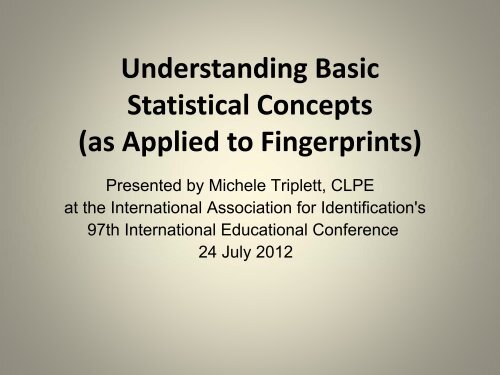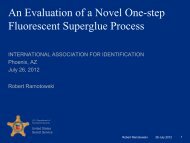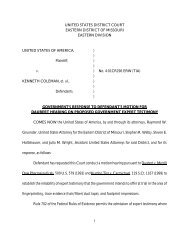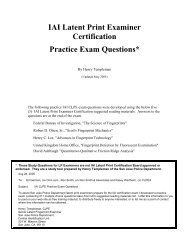Understanding Basic Statistical Concepts (as Applied to ... - Onin.com
Understanding Basic Statistical Concepts (as Applied to ... - Onin.com
Understanding Basic Statistical Concepts (as Applied to ... - Onin.com
- No tags were found...
Create successful ePaper yourself
Turn your PDF publications into a flip-book with our unique Google optimized e-Paper software.
Background
Explaining Probabilities
Fun with Statistics
Terms• Statistics – Collection and Interpretation of data.• Frequency –How many times an event happens.• Probabilities –The me<strong>as</strong>urement of how often an event willhappen when we aren’t certain (rate of frequency of events).Probability or Rate =Frequency enc of eent eventTotal number of possible out<strong>com</strong>es• Conditional Probabilities– Probabilities of an event happeningwhen we know additional information.(Probability of someone speaking Spanish vs. Probabilityof someone speaking Spanish who is from Spain).• Likelihood Ratios –Ratio of two probabilities under differentcircumstances, <strong>com</strong>paring the two probabilities <strong>to</strong> each other.• Bayesian Methods – Conditional Probability / BayesianInference.
Reverend Thom<strong>as</strong> Bayes1701‐1761, English Mathematician
Bayes’s s Theorem• Two applications• Both are used in situations where probabilitiescan’t be directly calculated.• 1) Conditional probabilities (with the ability <strong>to</strong>update the model dl<strong>as</strong> new blif beliefs areestablished).• 2) relate two events (known <strong>as</strong> BayesianInference).
Bayes Fac<strong>to</strong>rs
Establishing the Rate of Frequency ofan Occurrence (Event)• Cl<strong>as</strong>sical Probabilities ‐ percentage of possibleout<strong>com</strong>es (finite out<strong>com</strong>es)• Empirical Probabilities ‐ b<strong>as</strong>ed on a sample ofobservances (larger and relevant samples are btt better)• Subjective Probabilities ‐ user defines the probabilityb<strong>as</strong>ed on existing knowledge. Can be dangerous if useris using a gut feeling or experience instead of usingcurrent relevant knowledge.All methods are valuable for different situations.Choose the method that works best for the situation athand.
Different Uses of SubjectiveProbabilities• Yankee’s winning i a game b<strong>as</strong>ed on a gutfeeling.• Yankee’s winning a game b<strong>as</strong>ed on the otherteam having a lot of injured players.
Accuracy of MethodsThe results are <strong>as</strong> accurate <strong>as</strong> the data, the method usedThe results are <strong>as</strong> accurate <strong>as</strong> the data, the method usedand the thoroughness used. This means the results ofresearch are USELESS without knowing how they werearrived at.
Reminder• Cl<strong>as</strong>sical Probabilities – finite number ofout<strong>com</strong>es.• Empirical Probabilities ‐ b<strong>as</strong>ed on a samplegroup.• Subjective Probabilities ‐ user defines thejprobability.
Comparing Different Methods• Probability of it raining <strong>to</strong>day– Cl<strong>as</strong>sically: ll 1/2 out<strong>com</strong>es = 50%• Assumes equally likely events– Empirically: Sample group = 1/100 people = 1%• Assumes the sample looked at accurately represents the situation– Subjectively: Look of the window and see it’s cloudy = 85%• Can consider more information than supplied in the model• Probability of me winning an election– Cl<strong>as</strong>sically: 1/2 out<strong>com</strong>es = 50%• Assumes equally likely events– Empirically: Sample group = 9/10 people = 90%• Assumes the sample looked at accurately represents the situationp y p– Subjectively: With current knowledge I’m not running = 0%• Can consider more information than supplied in the model
Comparing Different Methods• Probability of <strong>to</strong>ssing a coin and getting heads– Cl<strong>as</strong>sically: 1/2 out<strong>com</strong>es = 50%• Assumes equally likely events– Empirically: Sample group of 10 <strong>to</strong>sses = could be 20%• Assumes the sample looked at accurately represents the situation• Assumes the sample group is an adequate size– Subjectively: = 85%• Can just be the gut feeling of the person• Can just be the gut feeling of the person• Probability of a long <strong>com</strong>mute– Cl<strong>as</strong>sically: 1/2 out<strong>com</strong>es = 50%• Assumes equally likely events– Empirically: Sample group of number of cars (low #) = 15%• Assumes the sample looked at accurately represents the situation– Subjectively: With current knowledge of fog (low #) = 90%• Can consider more information than supplied in the model
Comparing Different Methods• Probability of it being busy at work on aTuesday– Cl<strong>as</strong>sically: 1/2 out<strong>com</strong>es = 50%• Assumes equally likely events– Empirically: Sample group of Tuesdays = could be30% (Tuesdays are usually slow)• Assumes the sample looked at accurately representsthe situation• Assumes the sample group is an adequate size– Subjectively: = 85%• Knowledge of a big arrest
Benefits and Limitations• Cl<strong>as</strong>sical:– Benefit: Objective– Limitation: May not consider all relevant information• Empirical:i – Benefit: Can show that events don’t have the samefrequency of occurrence.– Limitation: Sample size may not be adequate, samplegroup may not be representative• Subjective:– Benefit: Allows one <strong>to</strong> consider current relevant data– Limitation: Allows for not using relevant data
Example 1Jamie gets 80% (80/100 or .8) A’s inher cl<strong>as</strong>ses. If she takes anau<strong>to</strong>motive cl<strong>as</strong>s, what is theprobability of her getting an A?Empirically: 80% (average from sample group)Cl<strong>as</strong>sically: 20% (1 out of 5 possible grades)(<strong>as</strong>sumes equal possibilities of each event)Subjectively:Could be 60% if she dislikes the <strong>to</strong>pic.Could be 99% if she likes the <strong>to</strong>pic
Which Method is Best?• Equal chance of each grade:P(A)= 1 A out of 5 possible grades = 1/5 = 20%• Empirically probability may show there’s not an equal possibility ofeach eventP(A)= 80%P(B)= 10%P(C)= 5%P(D)= 4%P(F)= 1%Cl<strong>as</strong>sical probabilities doesn’t consider all relevant information.Empirical probabilities may show frequency of each event is differentbut may not be showing other current fac<strong>to</strong>rs (desire).Subjective probabilities allows for other relevant data.
• What if we know the lower grades were or weren’trecent? Then the ‘current probabilities’ may bedifferent than the ‘overall probabilities’.• Need the sample group <strong>to</strong> be relevant (current) inaddition <strong>to</strong> being an adequate size.• Need <strong>to</strong> use the best method for the situation(cl<strong>as</strong>sical, empirical or subjective).
Example 2P(flipping 3 tails in a row)=Cl<strong>as</strong>sical, fair coin = (1/2)x(1/2)x(1/2)=1/8Cl<strong>as</strong>sical, unfair coin = 1x1x1 = 1Likelihood ratio of it being a fair coin = (1/8) /1= 1/8 the likelihood of it being a fair coin or 8 timesmore likely that it’s not a fair coin.Empirically=?? (Try it)Empirical probabilities are better with large samplegroups (in the long run –Law of Large Numbers).
3 Tails – 1 of 8 possibilities• HHH• HTT• HTH• HHT• TTT• THT• TTH• THH
Example 3• P(being born on January 1)=?Cl<strong>as</strong>sically = 1/365Are birthdays equally distributed throughout the year?What is it dependent on (fac<strong>to</strong>rs)?Which method would work best for determining thefrequency of birthdates?
Frequency of an EventIs it the same everywhere (equally distributed)?
Frequency of an Event• The frequency of a characteristic is different indifferent are<strong>as</strong> (enclosure under a core v. enclosureover a core). We don’t know the frequency ofcharacteristics. We haven’t found a mathematical wayof establishing the frequency of ridge events.
• How many points are enough?– Since we haven’t been able <strong>to</strong> establish thefrequency of features, cl<strong>as</strong>sical probabilities can’tdetermine a high probability that a certain numberof features are sufficiency (one re<strong>as</strong>on cl<strong>as</strong>sicalprobabilities biliti don’t work).– 10 <strong>com</strong>mon features may have less weight than 5un<strong>com</strong>mon features. Need <strong>to</strong> consider the rarity(weight of features).
Close Non‐MatchHenry Templeman
Only Considering L2…
… means you’re ignoring otherrelevant information
Questions for the Use of Statistics• How are probabilities and likelihood ratios going g<strong>to</strong> beused?‐ Use <strong>to</strong> support current conclusions (more accurate)?‐ Use <strong>to</strong> arrive at additional conclusions (for current‘inconclusive decisions’, lower the sufficiency needed)?‐ In 2010, the IAI rescinded their resolution stating nopossible, probable or likely conclusions. This w<strong>as</strong> not <strong>to</strong>incorporate statistical models, it w<strong>as</strong> <strong>to</strong> acknowledge thatconclusions are not absolute conclusions, they areinferences (subjective probabilities).The answer on ‘how stats will be used’ h<strong>as</strong>n’t beendecided yet. Decided in Feb 2012.
Questions for the Use of Probabilities• Are we looking at the probability of duplication?• Are we looking at the probability that the conclusion isin error?Majority of errors are not due <strong>to</strong> the possibility ofduplication, they are due <strong>to</strong> misinterpretation of data.
Misuse of Statistics• Interpreting the data one‐sidedly, ignoring grelevantinformation (intentionally and unintentionally).• Mathematical models may give a false sense of securityin a conclusion. Need <strong>to</strong> look at:– Is the sample size adequate– Is the sample group relevance– Is the frequency of events a good estimate– Are major fac<strong>to</strong>rs considered (perhaps: clarity, quantity,rarity (frequency), dissimilarities, intervening ridges,level 1, level 2, level 3)– Do the models account for misinterpretation?
Fingerprint Individuality ModelsGal<strong>to</strong>n (1892)• P(fingerprint configuration)= (1/16)x (1/256)x(1/2) 24• 24 regions• P(correct number of ridges entering andexiting)=1/256• P(pattern type) = 1/16
Fingerprint Individuality Models• Henry (1900), Balthazard (1911), Bose (1917)• 4 possible events (the events for each model weredifferent)• Assumed equal probability of each event• P(event)= ¼• P(a configuration)= ∑(¼) x(¼)x (¼) x (¼)… = (¼) n• For 10 minutia, one in millions• Expectation of how many would have this configuration= P(a configuration)/ number of people
Fingerprint Individuality Models• Wentworth (1918)• P(event)= 1/50, but had no list of the 50 features• P(a configuration)=(1/50) n• Assumed equal probability of each event
• Gupta (1968)Advanced Models• More possibilities of events• Established that the frequency of events isn’t equal• 1/10 for endings and bifurcationsi• 1/100 for others• Champod (1995)• 9 possible events• Improved the known frequencyof events
Generative ModelsGenerative Models incorporate ridge types (direction)• Pankanti, Prabhakar and Jain (minutiae only) 2001• D<strong>as</strong>s, Zhu and Jain (minutiae only) 2005• Fang, Srihari and Sriniv<strong>as</strong>an (minutiae and ridges) 2006
Differences in Models• Use different types of features• Use different frequencies for features• Use different mathematical equations• Tested their models on a different number offingerprints (e<strong>as</strong>ier with <strong>com</strong>puter technology)The research h<strong>as</strong> been valuable andlead <strong>to</strong> the use in biometrics and lights‐out technology!As more information is considered, the research may beable <strong>to</strong> be used for latent prints <strong>as</strong> well.
Current Models for Partial Prints• Chris<strong>to</strong>phe Champod’s Model – No info• Dactsys – Forensic Science Service (FSS) in UK– Original pro<strong>to</strong>type developed by Cedric Neumann in 2006• T‐Model – Henry Templeman– Original version rele<strong>as</strong>ed in Aug 2008• WOVI – Netherlands Forensic Institute (NFI) ‐ No info• Cdi Cedric Neumann’s Model– Used for 11 points and under. Wouldn’t account for the p<strong>as</strong>tproblem c<strong>as</strong>es.Very little is published on these models.None of these models have beenindependently validated.
Current Models for Partial Prints• Are these models an objective weight of conclusions?– Do they account for the major fac<strong>to</strong>rs?• Do they use empirical data?– B<strong>as</strong>ed on information in data b<strong>as</strong>es.• Are there subjective elements?– Examiners are still plotting points.
Views on Use for Partial PrintsJust starting questioning the validity of differentstatistical models. They haven’t startedevaluating models.Estimates it’ll take 2 million dollars and years <strong>to</strong>evaluate the validity of 4 models.Individuals:‐ Some think we’ll be moving <strong>to</strong> probabilities or likelihoodratios quickly ikl ; others think it is far off.‐ Most people feel it’s worth researching. They acknowledgewe need <strong>to</strong> be open <strong>to</strong> the use of statistics but questionwhether hth models dlhave a sound b<strong>as</strong>is.
Answering Questions in Court• Lots of models have been attempted since 1892.• Current statistical models are useful when you have alarge number of clear minutia.• No model h<strong>as</strong> been found <strong>to</strong> replicate reality accuratelyfor low number of minutia (<strong>to</strong>o much information isn’tconsidered).d)• Current models have not been externally validated.• Our conclusions (subjective probabilities) incorporatemore information than statistical models can considerat this time.
Answering in Court• Currently, our current conclusions are b<strong>as</strong>ed onsubjective probabilities. We consider L1, L2, L3,quality, quantity, rarity, intervening ridges anddissimilarities of features.• We make our current conclusion less subjective:‣ By arriving at conclusions that others would arrive at(inter‐subjectively testable).‣ By being able <strong>to</strong> explain the b<strong>as</strong>is behind ourconclusions.‣ By using objective data (data others would use or datay g j (others can see).
The Future• Statistics and probabilities are not new in fingerprintsbut many of us have been able <strong>to</strong> avoid them.• We’re no longer able <strong>to</strong> avoid statistics since modelsare being re<strong>com</strong>mended for use and because modelsare getting better (closer <strong>to</strong> being used).Everyone will need <strong>to</strong> be able <strong>to</strong> discuss b<strong>as</strong>ic conceptsabout statistics ttiti and probabilities.biliti
Most Important Concept• Be able <strong>to</strong> explain the benefits and limitations ofdifferent types of probabilities.– Cl<strong>as</strong>sical– Empirical– SubjectiveIf you can’t explain the value of the method you’reusing then others will exploit the limitations in aneffort <strong>to</strong> discount the value of your conclusion.• If you decide <strong>to</strong> discuss models with at<strong>to</strong>rneys, you’dbetter be able <strong>to</strong> discuss specific fac<strong>to</strong>rs of the models. dl
Terms and <strong>Concepts</strong> Not Included• Error Rates ‐ since errors seem so rare, a huge samplesize is needed <strong>to</strong> mathematically estimate error rates…Law of Large Numbers.• Mutually Exclusive –can’t happen at the same time(boy or girl, rich or poor)• Independent – one occurrence doesn’t effect otheroccurrences (I: rolling dice, dependent: pulling a cardfrom a deck of cards may be dependent on what cardswere already picked).There are different mathematical rules for differentThere are different mathematical rules for differentsituations.
Terms and <strong>Concepts</strong> Not Included• Sensitivity –can experiment find positive results, equation(or used with a different formula, incorporating fl false inconclusives)i • Specificity –can experiment find negative results, equation(or specific… not specific being non‐specificity, <strong>as</strong> in L2 and L3)(or rarity… which is the frequency)• Selectivity – ability <strong>to</strong> distinguish small differences(or used in place of the specificity equation)(or used with a slightly different equation, incorporating falseinconclusives)(or rarity… which is the frequency)These terms are used differently in chemistry and in statistics.Since fingerprints have both elements, people p are using the samewords for different meanings. Analysts need <strong>to</strong> consider how anauthor is using the word.
Quote of the DayStatisticians are people who like math but don’thave the personality <strong>to</strong> be accountants.
Questions?






